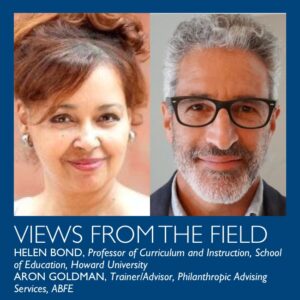Helen Bond, Professor of Curriculum and Instruction, School of Education, Howard University
Aron Goldman, Trainer/Advisor, Philanthropic Advising Services, ABFE
”What started out as a natural disaster became a man-made disaster.”
This is how President Obama described Hurricane Katrina, referring to both the disparate and devastating impacts on New Orleans’ Black community, and the historical and structural inequity that created the conditions for devastation.
Something similar can be said about the wildfires that ravaged Los Angeles in February, destroying a disproportionate number of homes and businesses in the historically Black neighborhood of Altadena. Altadena is home to a large concentration of Black homeowners, due in part to redlining dating back to the 1930s (see map). Redlining is a race-based exclusionary tactic that was used by the federal government and banks to deny access to home ownership primarily to Black families. This practice barred many Black homeowners and renters from integrating White neighborhoods. Altadena’s aging and already declining Black population means that this community will have more difficulty recovering and rebuilding, be more vulnerable to predatory lending during that process, and with reduced assets struggle more to build generational wealth, which is closely correlated with positive financial and health outcomes.
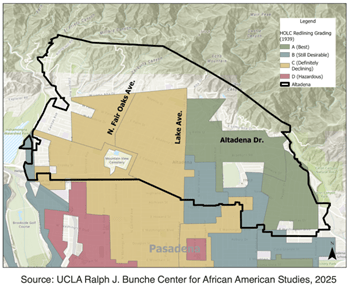
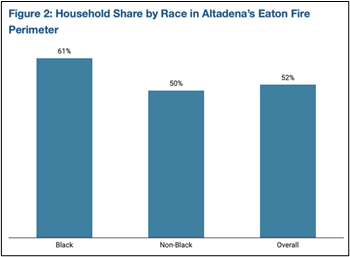
Wildfires and superstorms are becoming familiar events, and we are starting to understand their broad ranging and disparate social and public health impacts. It is increasingly clear that we must look beyond the specific region of impact to accurately evaluate it, identify root causes, and develop effective responses.
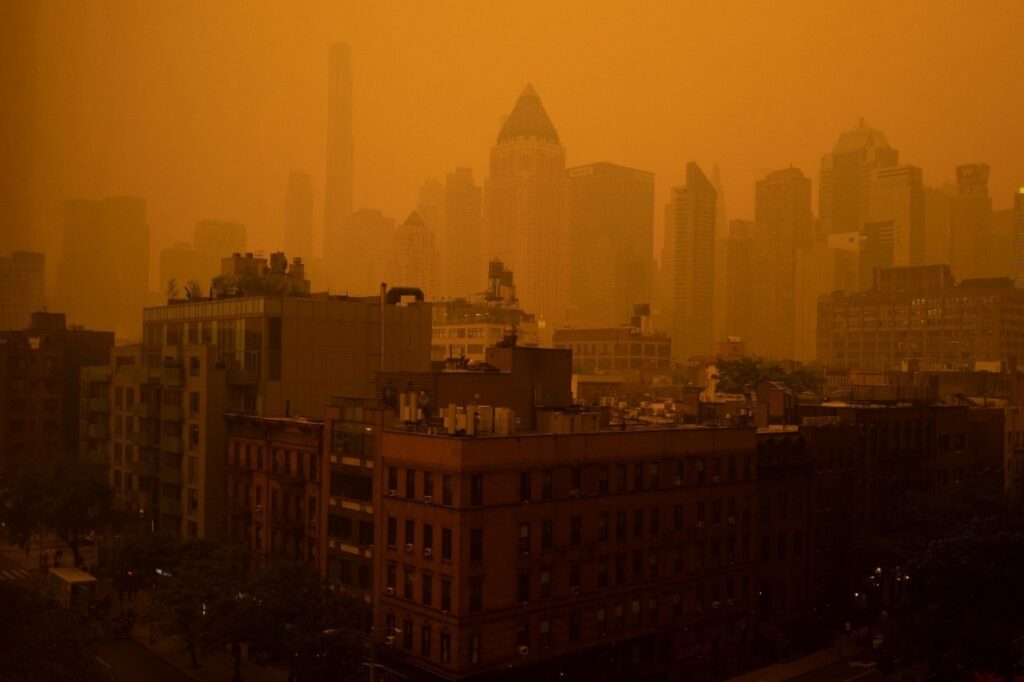
In 2023, Canadian wildfire smoke darkened the skies in New York City, exacerbating existing respiratory health disparities. Image by Shutterstock.
Enter Sustainable Development Goals
The number of recorded disasters has increased fivefold over the last 50 years, according to the United Nations Office for Disaster Risk Reduction (UNDRR). A study in GeoHealth found that Americans suffered more than $10 billion in health costs from 10 climate-related hazards in 2012, as global warming reaches 1.5°C (2.7°F). To reframe natural disasters as less “natural” and more the result of poor decision-making and inequitable human development, a risk-informed sustainable development strategy is needed.
The 2030 Agenda for Sustainable Development is a risk-informed strategy that recognizes how a broad range of interconnected factors weave a tangled web of mounting risk. The United Nations Sustainable Development Goals (SDGs) framework provides the structure to do this risk-informed work, offering local and global stakeholders powerful tools that are commensurate with the complex challenges they face today.
The SDGs are particularly valuable now, at a time when equity-driven work is being met with increasing resistance. The 17 individual SDGs are universally relatable objectives that UN member states have adopted and committed to. Starting with the legitimacy of global consensus and the broad appeal of universal objectives, communities can assess their individual circumstances and allocate limited resources efficiently where they are needed most, to move an entire community or region toward that goal. In this way, targeting resources advances an equity agenda while serving a universal objective. The SDGs are also timely because of the compelling data they provide to support a bold equity agenda. Historically, data has been used as a tool of oppression. But the SDGs help reverse these traditional power dynamics by disaggregating data demographically, which makes it possible to cross-reference equity outcomes regionally, nationally, and internationally. Equity-centered work is more difficult to dismiss when it is backed up by data and evidence that meets normative standards of rigor.

“In the Red”
Disasters don’t discriminate, but neither are they neutral. Due to preexisting disparities, marginalized communities continue to face disproportionate environmental impacts. Disaster risk reduction is critical to mitigating those impacts and achieving the SDGs. “In the Red: the US Failure to Deliver on a Promise of Racial Equality” found that on average, SDG delivery across the United States is highly unequal, with white communities receiving resources and services at a rate approximately three times higher than non-white communities. The unequal distribution of goods and services impacts a community’s level of preparedness, and its ability to mitigate risk.
By 2050, it is estimated that risk from earthquakes will increase from $370 million to $870 million, and rising sea levels could cost upwards to $35 trillion by 2070 according to UNDRR’s risk assessment. Yet nearly 99.7 percent of all hazardous events between 1990 and 2013 started small; disguised by either their slow-onset or small-scale nature.
While fires in the foothills of the San Gabriel mountains in southern California are nothing new, Altadena’s hazard risk started small and grew over time. In 1892, the Los Angeles Herald reported on a thunder and hail storm in Altadena, which was populated then by mostly wealthy white residents from Chicago and Iowa, according to the report. No injuries were reported. By 1906, a small house on the outskirts of Altadena caught fire, according to the Los Angeles Herald. A bucket brigade of volunteers formed a line to pass buckets of water to extinguish the fire. In 1907, the Los Angeles Herald reported a fire near a honey crop that raised the price of honey. Six people in a balloon flying over Altadena in 1909 spotted a large tract fire whipped by wind gusts according to the Herald. To mitigate increasing fire risks, one hundred fire hydrants were installed in Altadena in 1925 that lowered rising insurance costs according to the 2022 Altadena Heritage Newsletter Wildfire Issue. By 1935, the Los Angeles Herald described how 50-mile-an-hour winds fueled a fire that started in the Altadena district that swept through the Malibu Beach district with an estimated $4 million in damages. In 1944, a 10-acre brush fire destroyed a cabin in Rubio Canyon located near Altadena, leaving its 75-year old owner missing, according to the Imperial Valley press. By 1959, the Sidney Herald of Montana reported on a fire in Altadena that consumed some 2,100 acres of combustible vegetation fought by 1,300 firefighters from two states. In between fires, mudslides frequently fill the canyon. By the 1960s, the demographic composition of Altadena began to shift. White residents began to move out, while Black, Hispanic and other residents of color moved in.
Implementing the Sendai Framework for Disaster Risk Reduction 2015-2030 will help cities address the underlying drivers of risk, such as poverty, inequality, and climate change. Disaster risk reduction is core to achieving the SDGs and the “Leave No One Behind” agenda. Nothing sets communities back like the overlaying of a disaster on communities already burdened by discrimination and underdevelopment.
The Cohort
As we seek to understand and apply the impacts of SDGs for our sector, ABFE- A Philanthropic Partnership for Black Communities, has developed an interactive curriculum to support cohorts of community foundation leaders from across the country to help them align their existing priorities with the SDGs to advance their equity agendas. This year, we are partnering with CFLeads and augmenting the curriculum with their Community Leadership framework.
Anticipating concerns about overly technical and complex material, the program first asks participants to consider the current priorities and real-time concerns for the communities they serve in the context of the 17 SDGs.
Next, we introduce ABFE’s Responsive Philanthropy in Black Communities (RPBC) framework, using six themes that the RPBC and the SDGs “In the Red” analysis have in common:
- Racial equity is global in nature
- Metrics, benchmarking, and disaggregated data are essential to racial equity work
- Focusing on the least-served is the most effective way to improve overall outcomes
- A systems level approach is needed to understand and overcome structural barriers
- Targeted Universalism (i.e., targeted approaches to universal objectives)
- Data must inform action in the form of increased investment, power building, and solidarity
Fortified with an understanding of these frameworks and their relevance today, participants conceive and plan their own place-based initiatives. The program is now in its second year, and while structural change takes time, several participant organizations have begun applying the SDG framework.
The Community Foundation of Greater Flint is one example. In 2016, Flint, Michigan, made international news due to its contaminated water and the dramatically disparate impacts of the illness and death that resulted. The SDG framework provided the foundation with a tool to anticipate the next crisis and track both overall and disaggregated impacts. The next crisis was Covid-19, and the foundation was able to use the SDG framework to track the differential impact of Covid for their grantees and the overall population over time and relative to other regions.
Providing critical analytic capacity to the collaborative Greater Flint Coronavirus Taskforce on Racial Inequities, the foundation was able to quantify greater impact (in terms of infection rates, mortality, and other indicators) on Black and Latinx populations. In the context of the universal objectives captured by SDGs 3, 6, and 11 (Good Health and Well-being, Clean Water and Sanitation, and Sustainable Cities and Communities), the foundation was then able to refocus limited resources to respond to where the performance was lowest. As a result, the Foundation was able to show positive results overall, while almost completely eliminating disparities among groups.
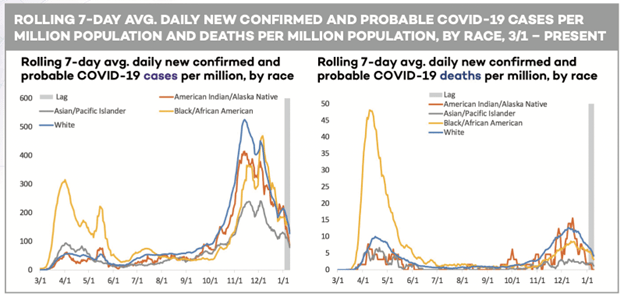
Without the SDG framework and the Leave No One Behind mandate, there would be no capacity to quantify and track disparities in the context of universally recognized objectives. Going forward, the Taskforce has become a permanent body focused on health equity, coordinating among sectors to build capacity.
The Foundation is also embracing the SDG framework and SDG 17 (Partnerships for the Goals) by partnering with Michigan State University’s Social Determinants of Health Solutions Lab. This partnership provides the surrogate capacity to collect, track, and interpret the disaggregated data.
Internally, the Foundation is using the SDG framework to guide the selection of a new institutional data system. The SDGs will also be integral to their upcoming strategic planning process, helping to identify equity priorities, to track them, and to communicate trends and impact effectively.
Another example is The Cleveland Foundation–the world’s first community foundation, established in 1914. The Foundation is a member of ABFE and a champion of ABFE”s Responsive Philanthropy in Black Communities (RPBC) framework. It created the Cleveland Black Futures Fund to strengthen Black communities and Black-led social change organizations in Cleveland, Ohio.
According to 2018 research from the Center for Community Solutions, Black children in Cleveland are more likely to live in poverty, be exposed to lead and live in unsafe neighborhoods. The Cleveland Black Futures Fund builds on the work of the African American Philanthropy Committee of the Cleveland Foundation (AAPC), finding the natural complementarity of ABFE’s RPBC and the SDG framework to mobilize funders, community-based organizations, and other stakeholders.
Cities and local governments are also well suited to using the SDG framework to advance their existing racial equity priorities. Goal 11 guides local and regional stakeholders toward creating cities and settlements that are inclusive, safe, resilient and sustainable.
Los Angeles, California, is an example of a diverse city, home to more than 175 languages with a $1.1 trillion regional economy, that has been an early adopter of the SDGs to promote racial equity. It is one of a handful of US cities that have created a Voluntary Local Review (VLR) to report on progress toward implementing the SDGs. Other US cities that have created VLRs include New York City, Orlando, Pittsburgh, Sacramento, and the state of Hawaii. The City of San Diego recently announced its plans in 2024 to develop its inaugural VLR reporting on the city’s progress toward achieving the SDGs and particularly its efforts in the climate and renewable energy sector.
Los Angeles has implemented several measures to address economic insecurity as a driver of racial inequality described in its 2021 VLR. The city implemented a $15 minimum wage, guaranteed income, and a justice budget. Recognizing how past discriminatory policies and practices contribute to current day disparities, Los Angeles established an accountability structure for gender equity in city operations. The city also created the Los Angeles Civil and Human Rights and Equity Department to address the long-standing discrimination impacting underserved communities in health, industry, education, employment, housing, and justice.
Other examples of practical initiatives community foundation cohort participants are pursuing include:
- A reallocation of early childhood grantmaking based on SDG indicators to increase community impact
- New evaluation metrics to be able to cross reference and better assess program performance data
- Partnerships with municipalities, employers, and the faith community to align and focus effort
- New fundraising and donor engagement messages and strategies
An essential element of the cohort’s success is creative inclusion. Beyond the usual suspects—we ask participating organizations to recruit a cross-sectional team of staff, as well as board members, donors, grantees, and other stakeholder groups. This approach leads to better integration and execution of the frameworks and improved relationships within each organization, which can in turn present many new opportunities for increased organizational effectiveness more generally. We also build in peer learning opportunities and foster connections among organizations that continue after the program ends.
Conclusion
Health equity outcomes, even at a very local level, are increasingly a function of global trends. Add to that an anachronistic culture and political environment that does not currently recognize the intrinsic and material value of equity—neither for specific groups nor for society overall. For funders who remain steadfast in their commitment to equity, at a moment when identity groups who have historically experienced oppression are more vulnerable than they have been in generations, a risk-informed SDG framework is an opportunity to build the sector’s capacity when it is needed the most.
ABFE is a membership-based, nonprofit, philanthropy-serving organization that advocates for responsive and transformative investments in Black communities. ABFE centers Black experience and excellence through its Philanthropic Advising Services, Peer Community Networks, and Signature Events. Click here to find out more about the SDG Cohort program and ABFE.

